Mkutano // A place for us by Valerie Asiimwe Amani
Boundary Encounters artist Valerie Asiimwe Amani joins us to explore friendship, courage and revival through stories from the Black Cultural Archives.
When Tanzanian artist and writer Valerie Asiimwe Amani discovered the fascinating journals and newsletters of the Organisation for Women of Asian and African Descent (OWAAD), she was transfixed. Commissioned as part of Modern Art Oxford’s 2023 summer programme Boundary Encounters, Amani created an immersive new installation in response to this OWAAD research spanning themes of community, friendship and bravery. Now the artist shares special insights into her research and artmaking process, including snippets of the OWAAD newsletters and journals that inspired the piece.
Premise
Ever since I encountered the Organisation for Women of Asian and African Descent (OWAAD) journals in August of last year I couldn’t really stop thinking about them. I loved the way they held space for all the areas that embody day to day experiences of women (of colour). From childcare tips; to poetry about colorism; satirical comic strips and deportation notices calling for community support. The journals embodied perfectly a phrase that the founding members lived by, “the personal is political.”
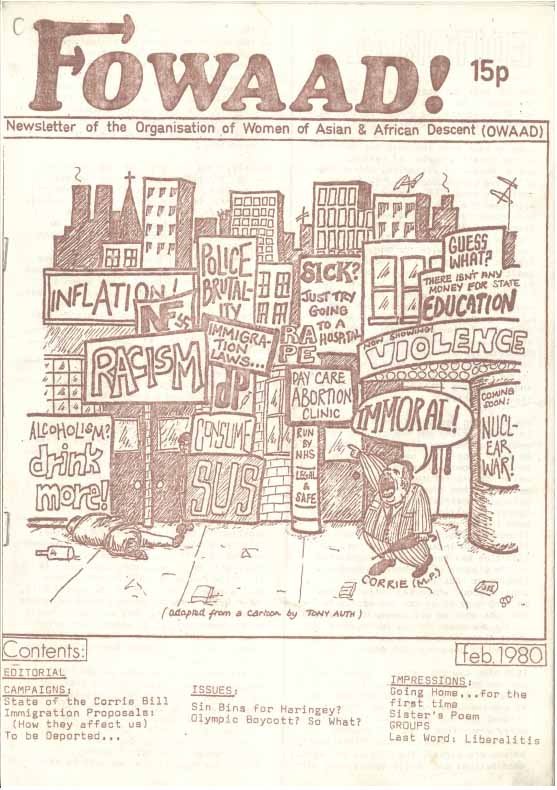

In approaching this commission, I reflected on the communal value of intersectional feminist ideology and how that may be present in my current life and the lives of the womxn around me. The journal which worked in conjunction with other black feminist groups in the country at the time (United Black Women’s Action Group, Black Women’s Collective, Southall Black Sisters just to mention a few) provided a combined space for validation, reflection, comic relief, education and practical protest.
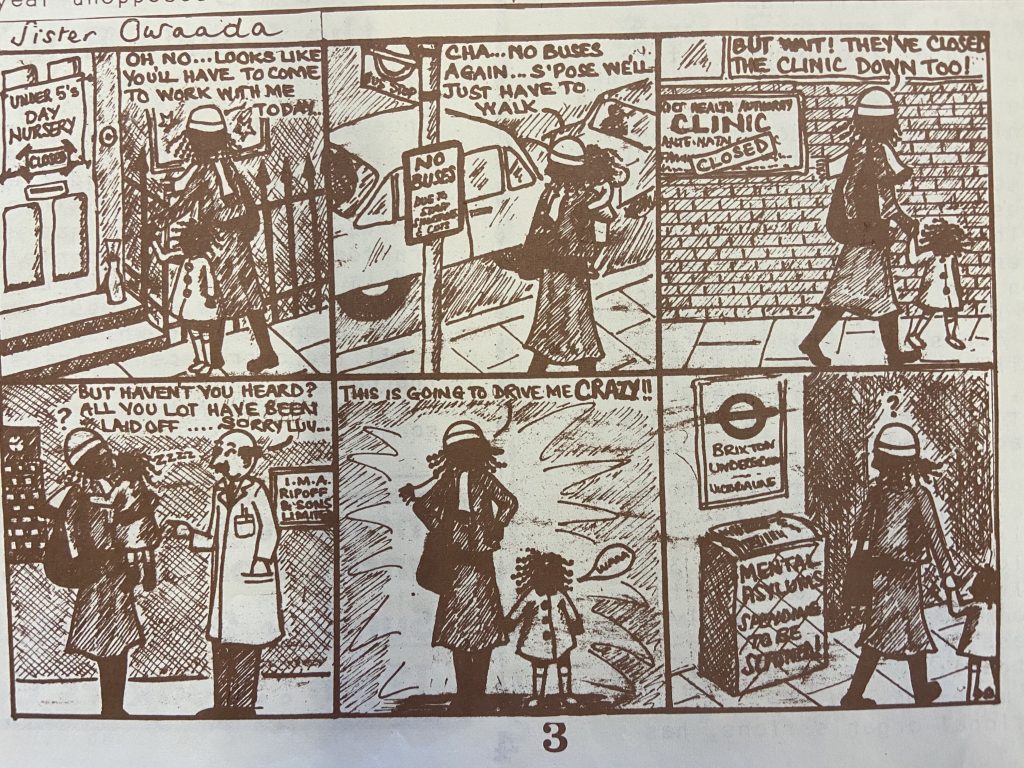
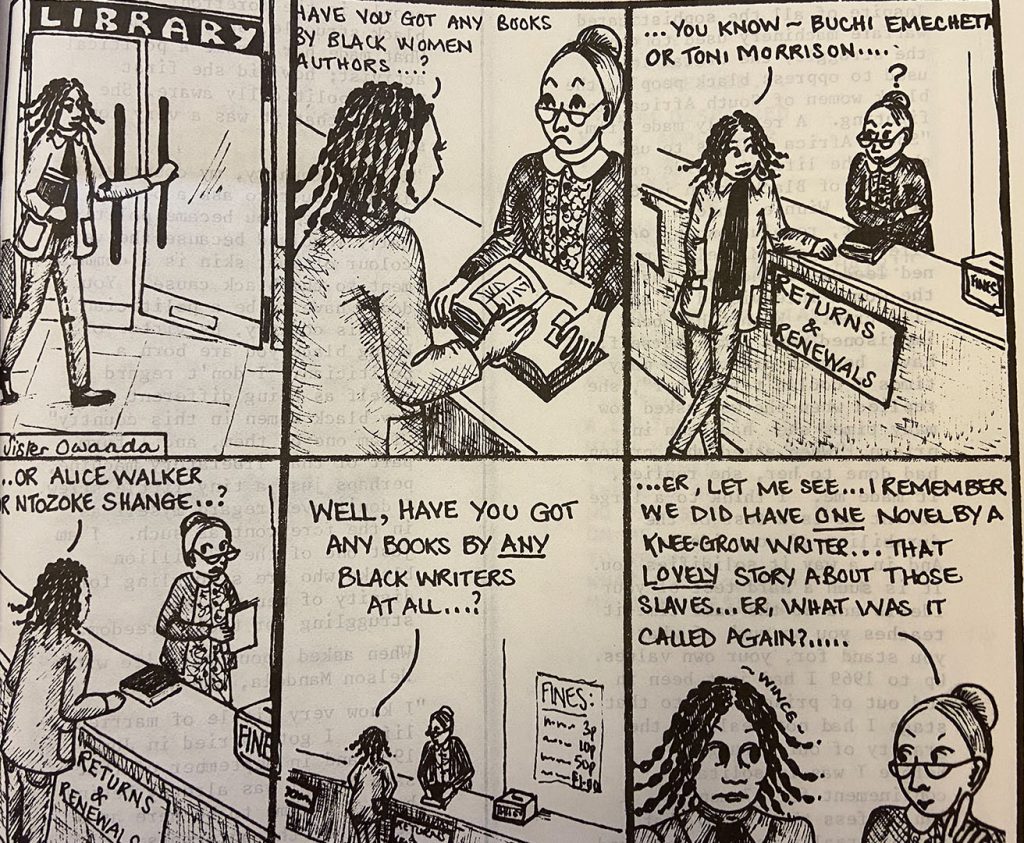
I loved that there was a glossary of legal terminology in one of the editions, as well as regular updates and calls to support other freedom movements (namely Apartheid in South Africa and Namibia). The richness and diversity of media formed the premise of imagining an installation that would not only acknowledge the daily challenges that comes with being human [and female] – but also uplift its joys and encourage a space to reflect on our interpersonal communities of care.
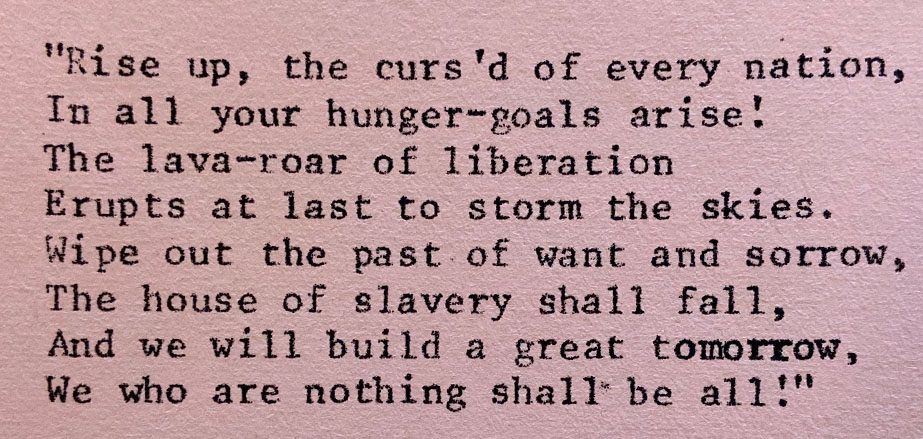
Notes on Phones
A lifetime collection of Whatsapp groups:
A female only group to share financial advice
A full moon group for tarot readings amongst friends
A group titled “soft life” [open to interpretation]
A group purely for memes that make you smile
A family group to collect money in times of emergency
A group to put together a funeral program
A wedding committee group for your siblings upcoming nuptials
A group with your work friends (purely to complain about work)
A sub-group from the main friendship group for non-sexual nudes to celebrate our naked bodies
After joining a female-only group that shares advice on saving, investing and everything in between, I start thinking about the ways in which community journals have transformed. We share music, news articles, photos, fundraising links etc etc via messages – and more often than not, Whatsapp. This platform has also become a main line of communication to my family that is spread over 3 continents.
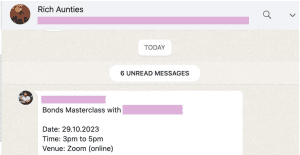
My friend Remi calls me, it is maybe a thursday or friday afternoon – our conversations normally start with a usual check in “how is your heart?”. 2 minutes in I start crying and am unsure why. I keep apologising, perhaps my hormones are going wild again. She reminds me that I don’t need to make excuses for spontaneous crying (none of us do).
My artistic decisions are [mostly] emotional. I do not get many chances to include friends and family; reading about migration has made me feel sentimental. I gather as many videos and photos as I can find on my phone and laptop. I also make a combined folder of all the GIFs I have received. Somehow this turns into two short video pieces.
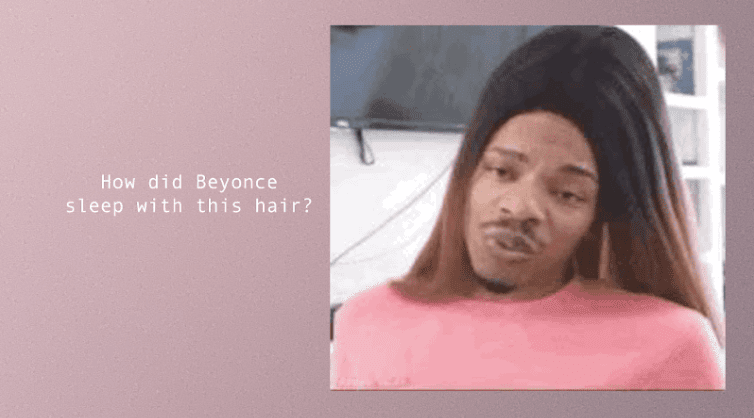
Decisions, Decisions etc etc.
Initial concept draft:
Mkutano // to join at the edge of each other’s fraying corners. Overlapping and mending; become a whole – one – in a part of many. To combat fear with unity. To use communal imagination for bringing to life a radically different future, that carves
- a space for all the ways of existing
- To treat the wounds of discrimination and rejection with friendship.
- To return constantly and consistently – to the centre – which is love.
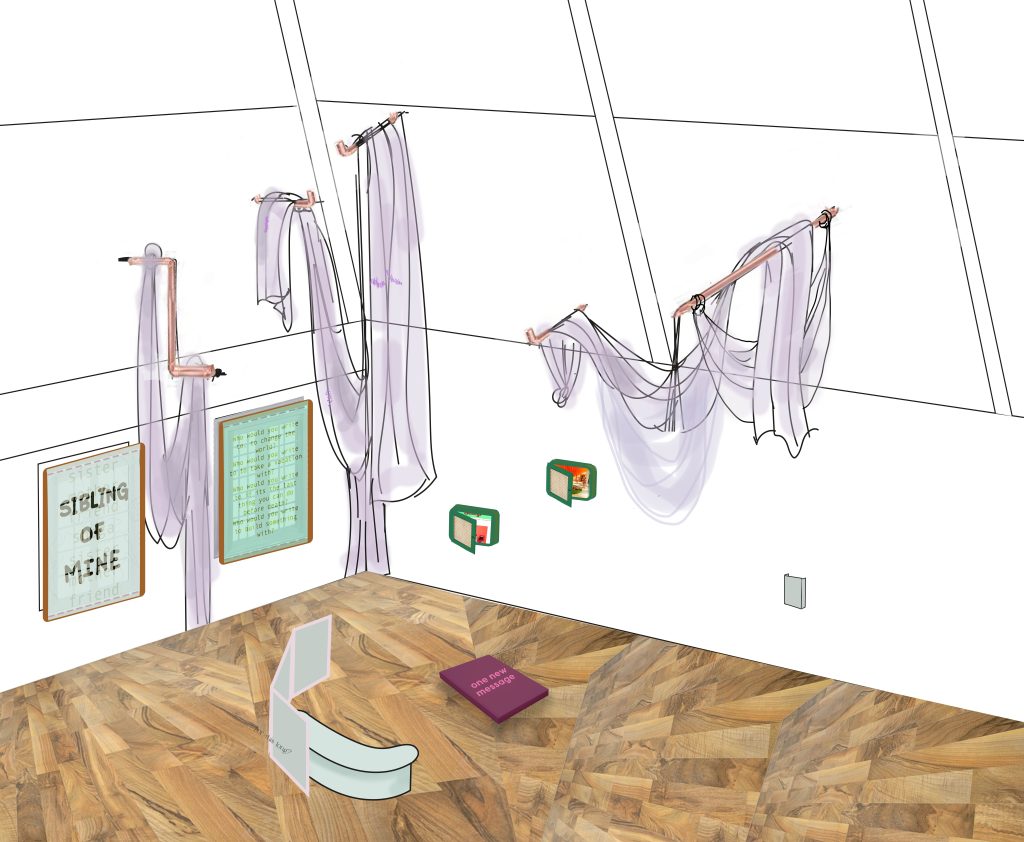
The first time I walked into Modern Art Oxford’s Upper Gallery I immediately knew I wanted to use the height of the ceiling in some way. There had been discussions of it being a space for people to work in, have meetings in. Going back to ideas of ‘the personal’, I was drawn to using second hand curtains, assuming that they were once used to maintain a feeling of privacy – that they are witnesses to the life we live inside our homes. Draping them over the bannisters I hoped to not only introduce a feeling of softness and familiarity, but also have the fabric speak to the life it has witnessed through text.
I. Colour

When I was younger, most of my drawings remained in grayscale. Committing to colour is still one of the most tedious parts of my process. I was grateful however, in this instance I could lean on the journals to help me. Various paper inserts were in a pink and green (office vibes) but I realised I quite like pink and green together.
Colour Happenings:
- Ordering the paint – Scot (Modern Art Oxford’s Production Manager) points out that the description on the green calls it “harmonious and nurturing.’
Angela, a friend, has been working with natural dyes for a while and she shows me a beautiful pink when I visit her studio. Together we pinkified over 50 metres of fabric…
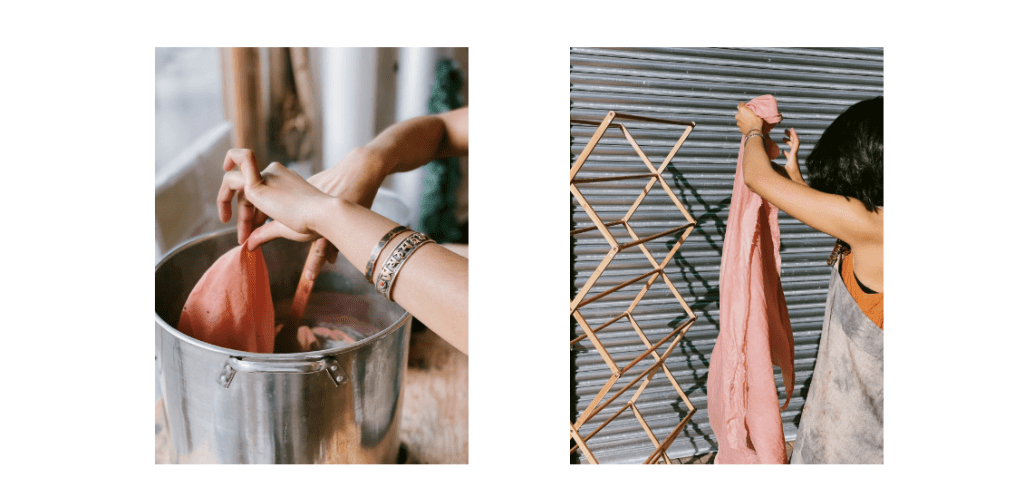
II. Words
A Poem of Poems, collected from fragments of 7 existing poetry published in the OWAAD Journals:
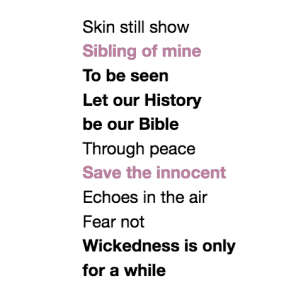
Words form the main body of the artwork. Every part of the installation has text – to guide, catalyse a smile or to invite reflection.
III. Feeling
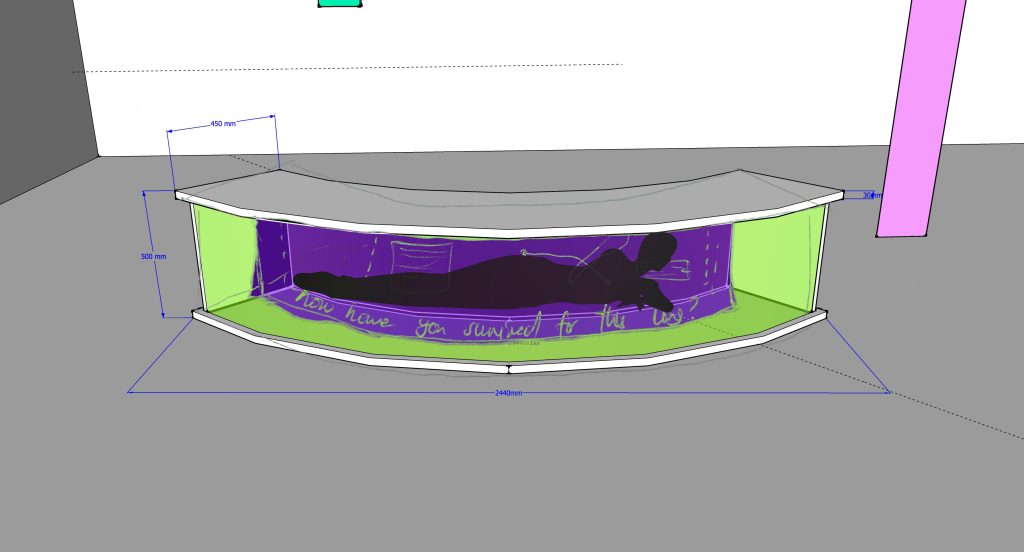
The question on the bench asks, “how have you survived for this long?”
I am not sure where exactly it came from but maybe it was a collection of feelings. In a world where we are bombarded with pain, hate speech and glorified bad news – it can feel difficult to feel connected to our humanity and empathy while also ‘choosing our battles’ and ‘protecting our peace’. In the end (for me) it is a question that births other questions. How do we keep love as our foundation? How can we physically manifest community, kindness and mutual respect when it feels like we are still being overlooked/unheard? Is just survival enough?
IV. Symbols
The final thing I consider important to mention is the symbols found on the window pieces. Besides being held by copper (copper as a migrating metal, copper as a healing metal) – there is a hand and map taken directly from protest posters and one of the cover drawings found in the OWAAD journals.
I chose to draw the outline of the cityscape as the issues the city in the drawing emanates are things we are still fighting against/hoping to move past. I will let people decided for themselves who ‘the innocent’ are.
The open hand was taken from an anti-apartheid movement poster and I later came to find out that it lives (along with the rest of the Archive of the Anti-Apartheid Movement) in Oxford, via the Bodleian Libraries. I’m still not sure how I feel about this.
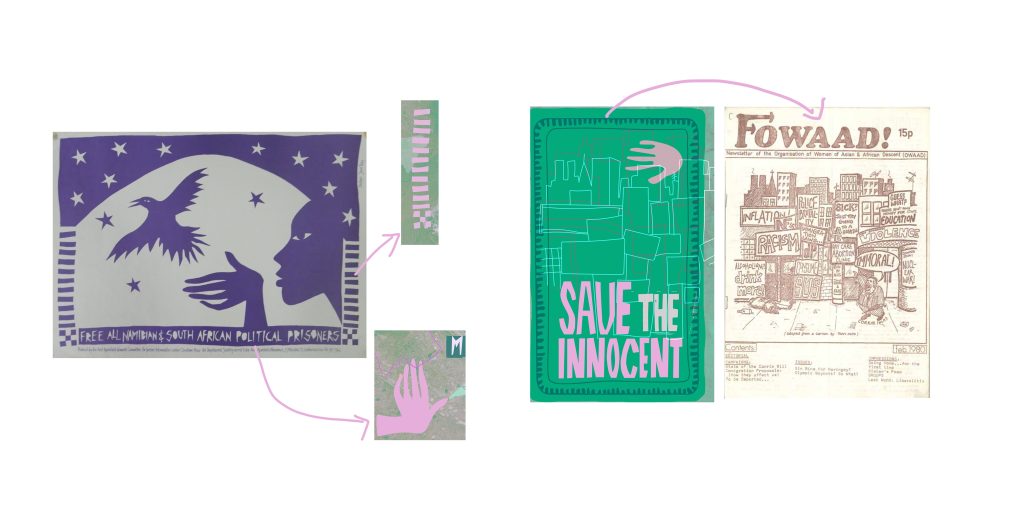
I will end with an invitation – inspired by the one found in the open (no longer empty) book.
The playlist below contains songs that invite you to dance with a friend, reflect, meditate, write a letter or just listen.
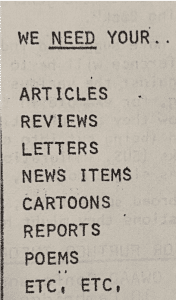
Special thanks to Jess, Scot and Andy from the Modern Art Oxford team for the time, skills and effort to make the installation what it is. I’m very grateful for the opportunity to bring this work to life.
Further thanks to the Black Cultural Archive and the Stella Dadzie Archive for the images.
Want to discover more about the work of Valerie Asiimwe Amani? Click here to read a short Q&A and explore more on the artist’s website.
